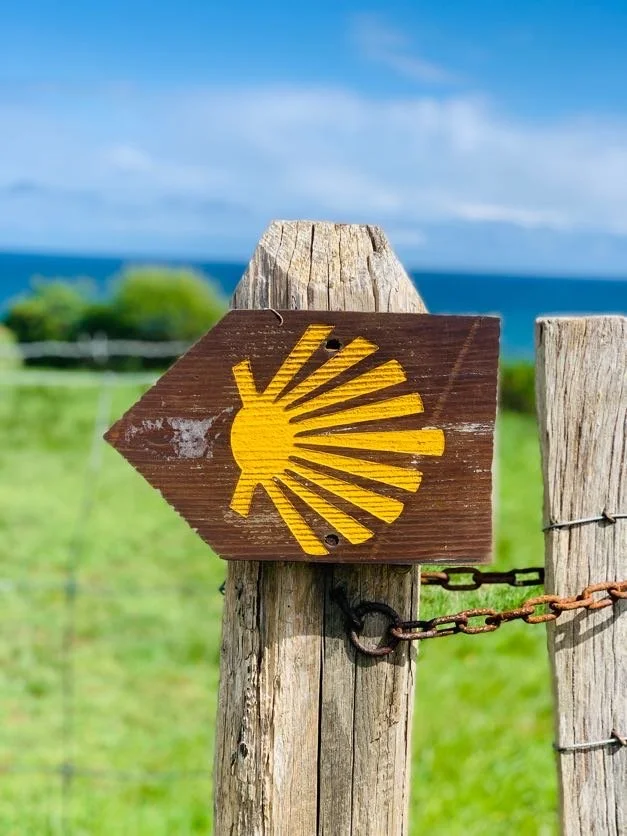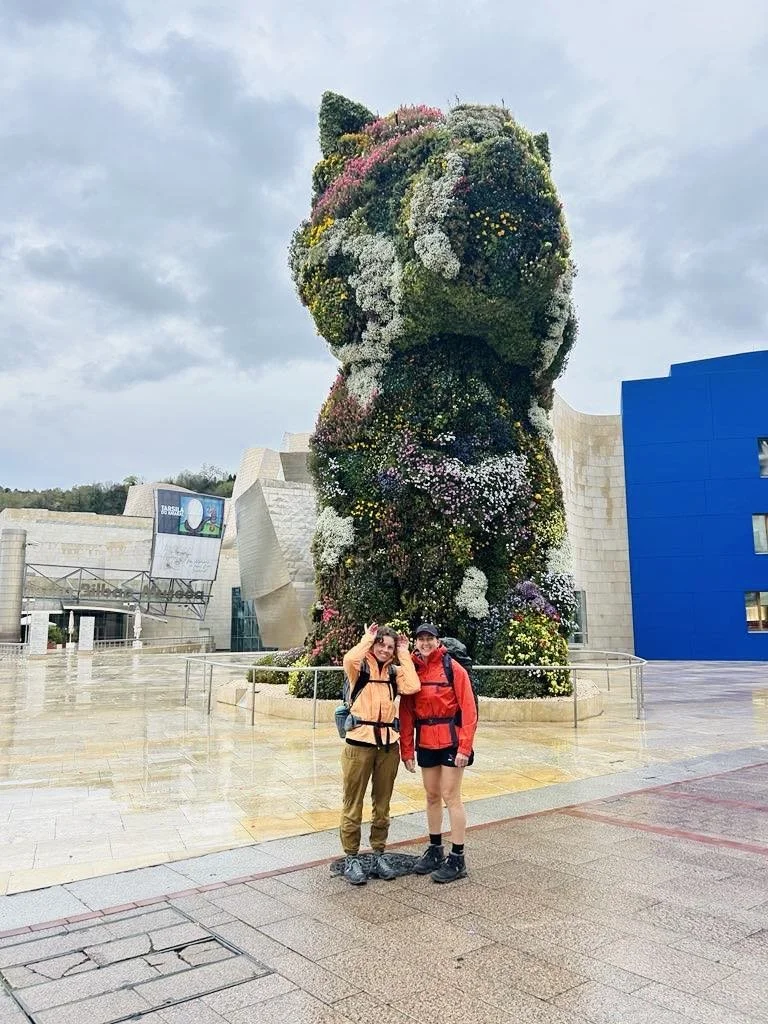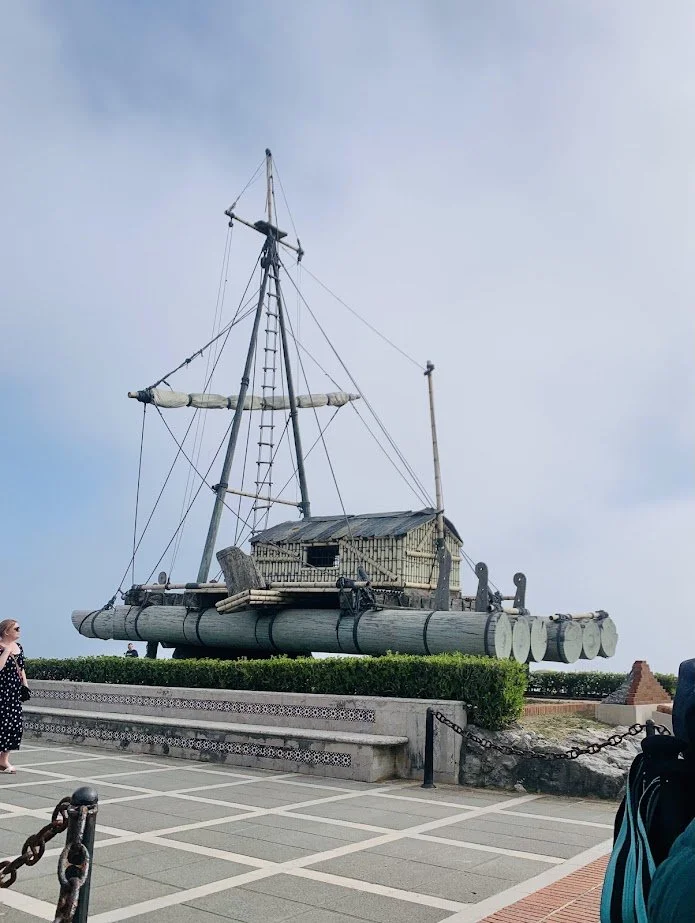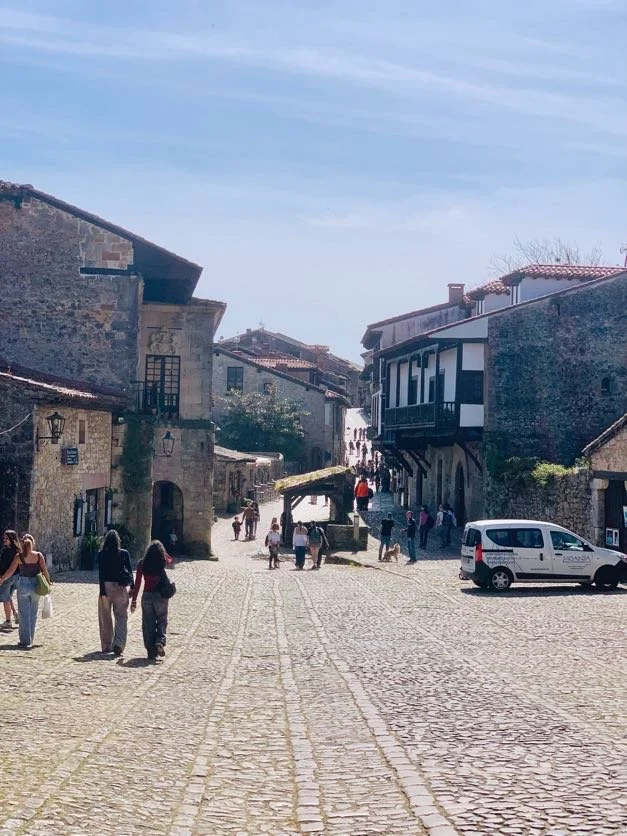2 Weeks on the Camino Del Norte
If you only have 2 weeks free to hike a section of the Camino de Santiago, Camino del Norte is my top pick!
The Camino del Norte in the north of Spain is described as one of the prettiest Camino routes among all the trails leading to Santiago de Compostela. Bright blue coastal lines with sea cliffs and tanned sandy beaches, mixed with peaceful farmland, rocky mountain views, coastal villages and bustling cities. You couldn’t ask for more variety.
What section should I hike?
I recommend starting in Portugalete and finishing in Colunga. This is the largest coastal section of the Camino del Norte before it starts heading inland. If you are flying into Spain, there is a main airport in Bilbao, and Portugalete is only a 30-minute train ride. Starting in Portugalete is a great option if you’d rather skip 10 km or so of industrial walking.
Just so you know, this post contains affiliate links; I may earn a commission from qualifying purchases. Thanks for your support!
What do I need to know?
Navigating the Camino del Norte: Yellow arrows and shells guide the way along the Camino del Norte. You can also download the free Buen Camino app on your phone. The app tells you where you are on the trail in real time and displays shortcuts or alternate routes for a more scenic view. It’s also helpful for seeing what accommodation is available in each town. Alternatively, we found having a physical pocket-sized guidebook for day-to-day planning was extremely helpful.
Public Transport: Our experiences with the buses in Spain were unreliable, but the trains and ferries we found were on time. All public transport tickets were relatively cheap.
Pilgrims walking the Camino who want to stay at Albergues must purchase a Camino Passport and collect 1 - 2 stamps per day. These stamps are proof that you are a Pilgrim. Daily stamps show your eligibility to stay in the Albergues or receive a discounted Pilgrim price at Hostels / Hotels. Albergues will stamp and date your Camino Passport. You can also ask for stamps from tourist information offices and some cafes/restaurants. If you decide to walk the entire Camino del Norte, the daily stamps in your Camino Passport render you eligible to gain a certificate of completion.
Staying at Albergues: Albergues are cheap Pilgrim dormitories that operate on a first-come, first-served basis, so it’s important to keep that in mind when planning where you will stay and when you will arrive. Some Albergues are donation-based; the recommended donation is €10 or €20 if meals are included. Most Albergues only take cash as payment. Many Albergues have a washing machine/dryer or hand wash stations for washing your clothes. Some also have simple kitchen supplies for cooking and a fridge. You can find more about Albergues’ amenities on their websites, through the Buen Camino app or in some guidebooks.
Staying at Hostels/Hotels: The trend seemed the further we walked, the more expensive the Albergues were. We walked in a group and found it more affordable to split the cost of a hotel. Some Camino walkers who met each other along the way also stayed at Hotels together. This can be a great option if you want to take your time and not worry about missing out on a spot at first-come, first-served Albergues.
Wifi and Mobile Data:
Wifi is available at Albergues, Hotels, and some cafes and restaurants. If you want to use the Buen Camino app or Google Maps on the go, purchasing an eSIM (electronic SIM) is a much more affordable option than using your home roaming data plan. I found Jetpac had the best eSIM plan for Europe, it’s simple to install, works instantly on arrival, and you can increase your plan for more data if you run out.
If you need a travel currency card for hiking in Spain, I recommend using Wise. Adding and converting currency in the Wise app is reliable, quick and easy. The ATM fees in Spain are quite high, so it’s smart to take out as much as you need for the trip to save you from extra unnecessary ATM fees.
What’s the trail like?
Beautiful, lovely, stunning! Along the way, you will see epic sea cliffs, wild flowers, lots of farmland and farm animals, quaint coastal villages and bustling cities. Be aware that a large part of the Camino del Norte is walking on concrete through villages and some roadside walking. The ratio of concrete to soft ground from Portugalete to Colunga is 7:3.
Supermarkets/Shops/Restaurants/Toilets:
In every village, you will find restaurants and cafes to purchase food. Eating out is a great option if you want to carry less weight. It’s also a fun way to get amongst the locals, have conversations and practice your Spanish coffee order.
If you plan on carrying food and snacks, you may find small supermarkets in small villages, but it’s a good idea to stock up on food for a day or two in bigger towns or cities. Take note, Supermarkets and shops likely close on Sundays or open late.
There are fountains along the way where you can refill your water, the water is safe to drink unless signed otherwise.
Public toilets are almost non-existent in Spain, except in the cities, and the ones we found were paid toilets. All cafes and restaurants have toilets you can use, and there are many along the way.
Food:
The main food on the menu in restaurants on the Camino del Norte route is seafood. But if seafood is not your thing, don’t stress, there are plenty of places to order a burger or meat and salad. Unfortunately, there’s not a huge range of vegan or vegetarian options en route.
What should I pack?
2x Shirts
1x Long Sleeve Base Layer (Merino)
1x Long Pants
1x Shorts
2x Socks
3x Undies
Rain Jacket
Rain Pants
Warm Fleece or Light Puffer Jacket
Hat / Sunglasses
Comfy Boots or Running Shoes
Sandles or Flip Flops
Small Quick Dry Towel
Warm Liner or Light Sleeping Bag
Basic Toiletries / Sunscreen
Travel Currency Card / Cash
Camino Passport
Water Bottle
How much should my pack weigh?
5-8 kg is ideal for the Camino pack weight. Everything you need will be available to you along the route. Keep a minimalist, lightweight mindset, and your body will thank you. You can also register for a bag transfer to each night’s accommodation.
Day 1 Portugalete - Pobena
Distance: 13.12km
Elevation: 159m
A warm-up day! If taking the train from Bilbao, make sure you take your time to stop by the giant flowery puppy statue in front of the very unique Guggenheim Museum. Once in Portugalete, wander through Spanish villages on your way to the first of many lovely ocean bays. Take a dip or settle into your night’s accommodation.
Where we stayed:
Muskiz Pilgrims Hostel.
Donation Based (€10 recommended).
Day 2 Pobena - Castro Urdiales
Distance: 26km
Elevation: 488m
Start the morning following the calm coastline. At the small village of Ontón you have the option of taking a shortcut and walking along the road for 4.77km. This is a more risky option on this busy, occupied road. We took a safer option on quieter streets, however, we walked more elevation, and the windy road had its dangers of tight hidden corners with no footpath. Follow the yellow arrows and shells through Baltezana, Otañes, Santullán, Samano before arriving at the beautiful city of Castro Urdiales built on the water’s edge.
Where we stayed:
Castro Urdiales Pilgrims Hostel.
Donation Based (€10 recommended).
Fun fact: the hostel is built in front of a bullfighting ring.
Day 3 Castro Urdiales - Laredo
Distance: 24.98km
Elevation: 520m
One of the most scenic days of the route. 70% of this day is ocean views and multiple options for a swim. The day starts leading you off the concrete beaten track and through a rocky bush path overlooking sea cliffs. Later in the day, as you incline, take in the epic panoramic views of the city of Laredo. The nightlife here is bustling with many great restaurants and bars to choose from. I can’t recommend the vibe and food at Dias Raros restaurant enough.
Where we stayed:
Casa de la Trinidad Hostel
Price: €10
Fun fact: This is an old monastery, and a sweet Spanish nun welcomed us to our dorm room. In the morning, we woke to cute hand-drawn Buen Camino pictures placed in our shoes!
Day 4 Laredo - Güemes
Distance: 34.99km
Elevation: 460m
This was another beautiful day. Leaving Laredo we walked along the beach outskirting the city and caught a 5-minute ferry Santoña for 2,50 €. We followed the coastline up to Noja and then inland through San Miguel, Bareyo and finally the rolling hills of Güemes. Here lies the famous Güemes Pilgrims Hostel of Father Enresto. Albergue volunteers host dinner and breakfast, and Ernesto kindly shares his family history with the Camino and outlook from his travels. This Albergue was memorable, warm and welcoming, especially after a mega day’s walk.
Where we stayed:
Güemes Pilgrims Hostel
Donation Based (€10 recommended).
Day 5 Güemes - Santander
Distance: 21.26km
Elevation: 213m
Coast day! Leaving Güemes, we straight-lined it for the coastal route and enjoyed sheer ocean cliffs spotted with wildflowers. Along the way is a stunning beach for a swim and plenty of views to eat a yummy mandarin. At Somo, we caught a 3,70 € ferry across to the happening ocean front city of Santander.
Where we stayed:
Santos Mártires Pilfrims Hostel
Price: €15
This Albergue allows you to stay more than one night upon request. Very friendly and helpful staff.
Day 6 Rest day in Santander
With lots to explore, Santander is the perfect stop for a rest day. We caught a bus to Parque de la Magdalena and rode a hop-on hop-off train ride featuring a Palace, a free mini zoo with Seals and Penguins, and historical ship displays. Worth the walk and the wander. Also in Santander city, pilgrims are allowed free entrance to visit the Catedral de Santander. In the afternoon we took the opportunity to catch a 20 min train to Boo de Piélagos to skip the industrial walk out of the city.
Where we stayed:
Apartamentos Dunas de Liencres
Alternate Albergue option: Piedad Hostel €16
Day 7 Boo de Piélagos - Santillana del Mar
Distance: 25.57km
Elevation: 450m
Rather than taking the train over the river, we settled for the more scenic route through farmland to the historical village of Santillana del Mar. This monumental town is paved with stone and is not short on sightseeing. There are tourist shops, a museum of torture we didn’t brave to enter, and a prehistoric painting in the Cave of Altamira, located 3km from the town. These streets are bound to take your imagination back in time.
Where we stayed:
Camping of Santillana del Mar
Price €20
Day 8 Santillana del Mar - Comillas
Distance: 21.50km
Elevation: 503m
Charming farming villages and distant seaside views. The highlight of Comillas was seeing the beautiful Palace of Sobrellano and the surrounding gardens. Embracing the daily bread consumption, we indulged in one of Comillas’ incredible Italian pizza restaurants, Restaurante Quo Vadis.
Where we stayed:
Pension Villa
Albergue option: La Magia del Camino Hostel. Price €21- 25.
Day 9 Comillas - San Vicente de la Barquera
Distance: 15km
Elevation: 155m
With the shorter distance, there was more time to explore the beaches. I found a beaten track off the traditional trail that followed the sea cliffs more closely, making for epic views between Playa de Oyambre and Playa de Gerra. If you walk to the end of Playa de Oyambre and continue onto the rocks, there is a white flag stuck into the rock. From there, you will see a steep track on the left-hand side leading into the eucalyptus trees with a tied rope for aid. Then you will see signs directing you to Playa de Gerra beach. Take note, this trail is uneven, steep with undulation, and will add distance to the 15km day, but worth it!
On the road between Comillas and San Vicente, you can also spy the Sierra de San Vicente mountain range with snow-capped peaks in April.
The most delicious restaurant of the trip was found here in San Vicente, The Green Wave! With fresh vegetarian options and all sorts of tasty, affordable meals and desserts. Yum!
Where we stayed:
Pension Arenal
Albergue option: Hotel Playa de Meron or Nómada Hostel. Price €25 - 30.
Day 10 San Vicente de la Barquera - La Franca
Distance: 21.99km
Elevation: 487m
We enjoyed following the trail inland through pretty farmland and villages. We witnessed a wedding celebration in one of the villages, onlooking from the wrong spot, we barely missed fireworks shot loudly in celebration meters from our faces!
Where we stayed:
Albergue Triskel
Price €25
This was a comfortable Albergue that offered home-cooked dinner and breakfast. It also had a cosy living area to hang out and chat by the fire.
Day 11 La Franca - Llanes
Distance: 23.33km
Elevation: 521m
Described as one of the most scenic days in the guide book. Unfortunately for us it was misty and raining but you can imagine on a sunny day these beautiful sea cliffs and tucked away bays would be a dream!
Where we stayed:
Albergue La Estación
Price €16-18
Day 12 Llanes - Ribedesella
Distance: 30.25km
Elevation: 522m
Hands down favourite day of the trip! I took the more scenic ocean route that between the towns of Poo and Celorio. The path was rocky with steep inclines and declines, but well worth the sweat. The views were clustered with natural rock arches, some may even walk over without realising! Take note it will add extra kilometers to the already long day.
Where we stayed:
Hotel Rural La Curva (Note this is a couple of extra kilometres off route!)
Albergue option: Camping Los Sauces, Price €15
Day 13 Ribedesella - Colunga
Distance: 23.81km
Elevation: 441m
On our last day, we saw the most pilgrims on the route. We felt spoiled, it had been so quiet up until then. It was also the day we saw the most Historic Spanish huts called Hórreo’s, which are raised granaries.
Where we stayed:
Hotel Villa de Colunga
Day 14 Rest and travel from Colunga - Asturias Airport
We found the buses to be slightly unreliable, so we booked a ride share from the app BlaBlaCar to Piedras Blancas. Finally, in reluctance to say goodbye to the Camino, we walked the last part of the trail closest to us before veering off to Asturias Airport.
Just so you know, this post contains affiliate links; I may earn a commission from qualifying purchases. Thanks for your support!














